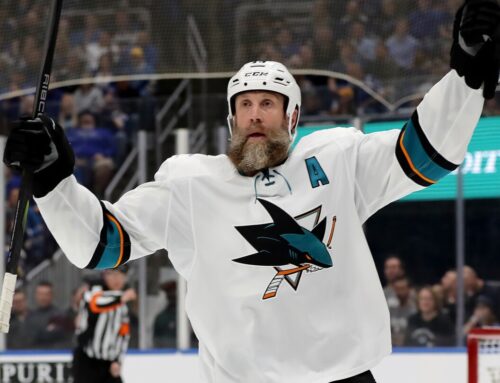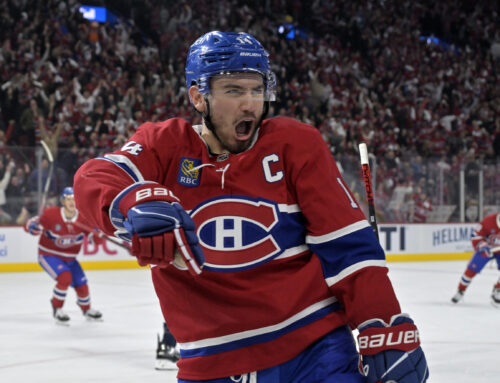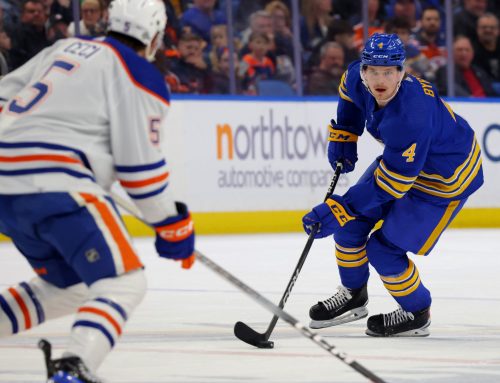
It is kind of hard to believe the calendar is turning to August, but that also means that fantasy draft season is just around the corner. Some may be taking part in drafts already, some in the near future, but many are already at least thinking of drafts.
This exchange from Dobber’s own Cam Robinson and Steve Laidlaw caught my eye the other day:
He was going in the 55-70 range in drafts last year and injury curbed his breakout so I presume his top-10 roto status is under the radar.
— Stephen Laidlaw (@SteveLaidlaw) July 29, 2017
Read through to get their thoughts.
To the point of Jack Eichel, I agree with those two on that point (though I am less agreeable on some other points). I thought it would be fun to take a spin through Eichel’s performance so far in his young career in historical context, with numbers pulled from Hockey Reference’s Play Index. He is sitting at 142 regular season games through his Age 20 season thus here are some notes on forwards who fit that criteria as it relates to Eichel:
- There have been seven forwards to manage at least 0.8 points per game this century: Ilya Kovalchuk, Anze Kopitar, Sidney Crosby, Patrick Kane, Jonathan Toews, Steven Stamkos, and Eichel.
- There have been 11 forwards to manage at least 0.34 goals per game this century: the seven already named, plus Marian Gaborik, Rick Nash, Jeff Skinner, Sean Monahan, and David Pastrnak.
- There have been six forwards to manage at least 0.46 assists per game this century: Kopitar, Crosby, Kane, Stamkos, Ryan Nugent-Hopkins, and Eichel.
- There have been four forwards to manage at least 3.4 shots per game since the NHL started tracking shots on goal: Dale Hawerchuk, Wayne Gretzky, Kovalchuk, and Eichel.
- Those same four players just named in the point above are the only ones to average 0.8 points per game and 3.4 shots on goal per game.
Aside from a couple of misses (RNH turned out to be a two-way centre, Toews hasn’t had a 70-point season in six years, and the jury is still out on Monahan), there are a lot of impressive names in that list. Eichel has been incredibly valuable in his young career when he stays healthy.
The young star is in a good situation where he should get loads of ice time, and prime power-play minutes. He shoots a lot, and has wingers who can finish. He was drafted around the 50th pick in leagues last year, and I’d wager he doesn’t move up much this year. I’m in agreement here with my two fellow writers; I’m grabbing Eichel in the third round, assuming 12 teams, in every league possible. Perhaps even the end of the second if necessary.
****
Be sure to grab your copy of the Dobber fantasy guide from the Dobber Shop! Releases on August 1st!
****
Throughout the summer, I’m going team by team to review the relevant fantasy performances from 2016-17, and what it could mean moving forward. The next team in the alphabetical list is San Jose.
The shot volume fell from 2015-16 to last year, but still managing 3.9 shots on goal per game as a defenceman is a monster number. A small shooting percentage spike saw him fall one goal short of 30 tallies, but his 76 points gave Burns back-to-back seasons of at least 75. Over the last three years, he’s 13th in the league in scoring, out-producing guys like Ryan Getzlaf and Johnny Gaudreau.
One interesting note here is that his shot attempt rate at five-on-five actually increased last year, but his shot on goal rate declined. If he hits the net and avoids a few more shinpads, he could top four shots on goal per game again next year.
If there is a concern here, it’s that the time on ice per game Burns enjoyed in 2015-16 went down by a full minute last year. In and of itself, that’s not an issue, but the problem is over half that decline came from power-play time. His points per 60 minutes on the PP over the last three years is just over 5.00, which means 33 seconds lost per game is about four fewer PP points. That is just through lost ice time; a poor-performing power play could hurt even more. What saved him from further decline in PPP was the fact he managed a point on nearly 69 percent of goals scored with him on the ice. That number was 58.2 percent over the previous two seasons. Had he managed just 58 percent in 2016-17, he could have seen his PPP dip below 20. At that point, it’s a serious fantasy problem.
There is no doubt Burns is an elite fantasy asset, and there isn’t any real sign of slowdown here. Where you decide to draft him is up to you – I personally don’t usually draft d-men in the first round, but that is not a hard-and-fast rule. The team needs to improve in the penalty-drawing department, though, to help Burns boost that PP TOI, and help mitigate any decline that may come. I don’t think his PP totals crater or anything, but I do think we’ve seen his high-water mark, and 2016-17’s power-play production is more of what to expect than 2015-16.
Following five straight 82-game seasons with at least 30 goals, Pavelski managed 29 in 2016-17, with 39 assists added. It was his sixth straight 60-point season (lockout-shortened season notwithstanding), and fourth straight season with at least 20 power-play points. Even with a small decline in production, it was still a very good year for the Sharks’ centre/winger.
Pavelski’s decline in goals was largely caused by a decline in power-play tallies. Over the three seasons from 2013-2016, he managed 47 goals with the man advantage, averaging nearly 16 per campaign; he had just seven last year. Much like Burns, a decline in power-play points was thus inevitable with a decline in PP efficiency and total opportunities for the team.
One reason for the decline in goals was a decline in shots, though I’m not sure that’s a result of a decline in skills. Rather, Burns has seen his power-play shot rate increase each of the last two seasons, culminating in a career-best last year. Logan Couture, similarly, had been one of the team’s heavy-volume shooters on the power play for a few years. In 2015-16, Couture missed 30 games due to injury. He played 73 last year, which means, in conjunction with Burns shooting more than ever on the San Jose PP, that there were fewer shots for Pavelski to take.
That wouldn’t be a problem if the team was taking more penalties and saw a correlated rise in shots with the man advantage, but San Jose as a team had a four-year low in power-play opportunities, and a four-year low in shots on goal per minute. With other players shooting more, and Couture healthy for the most part, there was less opportunity for Pavelski with the man advantage. Pavelski himself had a four-year low in PP shooting percentage, so it was a perfect storm for a goal decline.
Whether that changes next year depends on whether San Jose changes their priorities on the PP. If Couture is healthy again, and Burns is firing shots at every available opportunity from the blue line, maybe 8-10 PP goals will be Pavelski’s new norm.
The best news the 33-year old winger could receive career-wise was when Joe Thornton agreed to re-sign with the Sharks for a year. He is far more productive – 2.05 points per 60 minutes at five-on-five with Thornton compared to 1.57 without over the last four years – so it’s good for him to have his running mate back. How much Thornton has left in the tank remains to be seen, as well as his recovery from his knee injury.
So long as he stays on the top line and top PP unit, Pavelski should still hover around 30 goals and 70 points. His prospects still look good for 2017-18. Beyond that, however, is up in the air, and now might be a good time for keeper league owners to see what he might fetch in a trade.
In the 2013-14 season, Couture set a career-high in shots on goal per game with 3.58. Since that season, that number has declined each year, bottoming out at 2.38 last season. That number is the second-lowest of his career, and the lowest since his rookie year in 2009-10.
The section on Pavelski discussed how when Couture is in the lineup, he’s a volume shooter on the power play for the Sharks. This remains true, though his shots on goal per minute at five-on-four have dropped by nearly one-third (18.2 to 12.8) in the last four years.
His decline at five-on-four isn’t really a huge problem. That would account for about 20-25 shots over a full season. The bigger problem is that the 2016-17 season saw his lowest shot on goal, and shot attempt, rate of his career, and his shot on goal rate in particular has been declining for four years. You could blame one injury or another for a one-year blip, but a decline of four years is concerning. In the lockout-shortened season, when he posted his career-best 10.25 shots on goal per 60 minutes of five-on-five, he was in the top 10 percent of the league in that regard among regular forwards. In 2016-17, his rate of 7.14 was just inside the top 50 percent of regular forwards (120th out of 262 forwards in the sample). He has usually been a high-percentage shooter, averaging 11.6 percent from 2009-2016, but that drop in volume will make it very hard for him to get back to the 30-goal plateau he was accustomed to early in his career.
Couture, for years, was a high-volume shooter, but a drop in his shot rate mixed in with a decline in ice time makes it hard to rely on him at this point. Until he is given more ice time (and maybe he will be if he can prove himself healthy to the coaching staff), or that rate jumps back up, it’s hard to expect more than 25 goals or 60 points from him. He doesn’t stuff real-time stats like hits or blocked shots, he doesn’t take penalties at all, and his shot volume has dropped consistently for years now. Last season, he was often drafted with hopes of being a top-50 roto option. At this point, the hope should be for top-100. Unless his ADP is outside the top-75 this season, I won’t be reaching for him in drafts.
3 Comments
Leave A Comment
You must be logged in to post a comment.





 UTA
UTA PHI
PHI VGK
VGK EDM
EDM NYI
NYI VAN
VAN L.A
L.A ANA
ANA CBJ
CBJ BUF
BUF

Cool article and I love Eichel but this is not entirely correct.
1) Both Malkin and Ovechkin are not listed in the shots-per-game or points-per-game lists even though both meet the requirements. (Possibly more players too, this was just top of my head)
2) Not including McDavid in any of the stats even though he’s same draft class as Eichel.
Love the site guys keep up the good work!
Heck, Bailey, why stop there? I love Eichel and all, but those stats are a little misleading. Seven forwards have managed a 0.8 ppg average this century? With three quick clicks, NHL.com shows me 72 players to have done so, throwing out the single-game players. Yes, even Yashin, Martin Straka and Patty Elias. That’s this century, as in since 2000-2001. Did Clifford mean this decade instead? As in, since 2010-2011? Clearly not, as, once again throwing out the single-gamers, Eichel sits at 37th. Max Pac, Spezza, both Sedins, etc etc. And yes, I see as many or more for the next stat (“There have been 11 forwards to manage at least 0.34 goals per game this century”): we’re talking 70+ players, including names like Satan, Cheechoo, Arnott, Jeff O’Neill, Eric Daze, and yes, Adam Deadmarsh. If we mean just recently, well, Patrik Laine comes to mind… heck, even Jake Guentzel’s regular season was at 0.40 goals per game. So yeah, I have no idea where these numbers are coming from either.
Still, I agree that Eichel’s going to be special and is still somewhat underrated for what he’s shown in his young career. But let’s not go by the numbers quite yet.
Bad article, misleading and wrong data. Do more research its not hard to find…